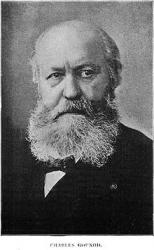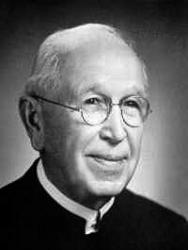1816 - 1873 Person Name: William Pennefather Hymnal Number: 803 Author of "Jesus, Stand Among Us" in The Worshiping Church Pennefather, William, B.A., son of Richard Pennefather, Baron of the Irish Court of Exchequer, was born in Merrion Square, Dublin, Feb. 5, 1816. He resided for a time for educational purposes at Wesbury College, near Bristol, and then at Levans Parsonage, near Kendal, Westmoreland. He entered Trinity College, Dublin, in Feb. 1832, and graduated B.A. in 1840. Taking Holy Orders in 1841, he became curate of Ballymacugh, diocese of Kilmore. In July, 1844, he was preferred to the Vicarage of Mellifont, near Drogheda. In 1848 he removed to England, where he held successively the Incumbency of Trinity Church, Walton, Aylesbury, 1848; of Christ Church, Barnet, 1852; and of St. Jude's, Mildmay Park, 1864. He died April 30, 1873. His great work at Barnet and at Mildmay—-the Conferences began at the former and continued at the latter place-—the large religious and charitable organizations which he instituted and superintended, are matters of history. Full details are given of the rise and progress of these and his other works in his Life and Letters, 1878. His hymns were written mainly for the Barnet and Mildmay "Conferences," and were published sometimes as leaflets, and again, as for the Conference of 1872, as Hymns Original and Selected, By W. P. In this pamphlet there are 25 of his compositions. In the latter part of 1873 his Original Hymns and Thoughts in Verse were published posthumously. This work contains 71 pieces, but few of which are dated. Of these the following are given in a few hymn-books:—
1. And may I really tread. Divine Worship.
2. Help us, 0 Lord, to praise! Praise.
3. How shall we praise Thy name. Christian Communion. From this “0 for ten thousand harps," is taken.
4. Jesus, in Thy blest name. Church Conferences.
5. Jesus, stand among us. Divine Worship.
6. My blessed Jesus, Thou hast taught. Self Consecration.
7. 0 God of glorious majesty. For Retreats or Quiet Days.
8. 0 haste Thy coming kingdom. The Second Advent desired.
9. 0 holy, holy Father. Divine Worship.
10. 0 Lord, with one accord. Divine Worship.
11. 0 Saviour! we adore Thee. Jesus the Faithful One.
12. Once more with chastened joy. Divine Worship.
13. Praise God, ye seraphs bright. Praise.
14. Thousands and thousands stand. Communion of Saints.
15. Yon shining shore is nearer. Heaven Anticipated. Mr. Pennefather's hymns possess much beauty and earnest simplicity; are rich in evangelical sentiment and doctrine; and are much more musical than is usual with lyrics of their class
-- John Julian, Dictionary of Hymnology (1907)
W. Pennefather


 My Starred Hymns
My Starred Hymns






